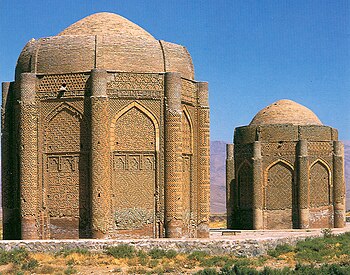Charaghan tombs
The Charaghan tombs ( Persian خرقان Charaghān , DMG Ḫaraqān ) are Seljuk burial towers ( Gonbad ) from the 11th century. They are located in the province of Qazvin near the village of Hesar-e Armani , about 30 km west of Abegarm between the northern Iranian cities of Qazvin and Hamadan .
The towers are said to go back to the architects Muhammad bin Makki al-Zanjani and Abu'l-Ma'ali ibn Makki al-Zanjani . As far as this presumption is correct, the latter could have been the brother or son of Muhammad bin Makki al-Zanjani .
Discovery story
Both tower tombs became known to the international public late. It was not until the spring of 1965 that David Stronach and his companion T. Culyer Young from the Royal Ontario Museum explored them . Stronach, then head of the British Institute of Persian Studies, found her on a study trip to western Persia, where he devoted himself to Iranian archeology . He had put emphasis on the research of Median and Achaemenid traces. The chance find of the tomb towers is one of the most important cultural and historical discoveries, because it is the earliest double-dome construction in Iranian architectural history. At the time of discovery, it was in an exceptionally good state of preservation.
Since then, many inscriptions have given up puzzles that cannot be easily assigned with regard to the names recorded in them. It is not sufficiently clear whether they were builders or buried in them. This is attributed to the fact that the (possibly incorrect) grammar and the abbreviated rendering of the information contained in the lettering require prior knowledge , the lack of which only allows insufficient access to the meaning.
System architecture
The grave towers are about 15 m high brick buildings that date from 1093 (western tower) and around 1067/1068 (eastern tower). The base of the towers is octagonal . At the corners of the octagonal masonry, round columns are arranged as supporting pillars, which are largely free. The wall surfaces between the columns are loosened up by ogival arcades . Over one hundred ornamental patterns shape the appearance of the entire ensemble. A brickwork separates the dome zone from the substructure. Below the Ziegelflechtwerks turn includes kufisches inscriptions fries from the pointed arches at the level of the crown. The partly religious, partly historical inscriptions leave open who was buried in the towers. It can only be assumed that it was a matter of high-ranking Seljuk nobles. Both the blind arcades and the pillars and segments of the brickwork have different ornaments .
The domes of the towers are double-skinned and are considered to be the earliest of their kind in Iranian architecture. The inner half-shell forms the ceiling of the tombal interior. Leaving out a gap, another hemispherical shell is built above it, which gives off the spherical roof visible from the outside. In the east tower two spiral staircases - one in the west tower - lead into this narrow space between the shells, which is accessible through low doors from inside the burial chamber.
The western tower has a mihrāb .
There are well-preserved murals and frescoes in the eastern tower. One illustration shows, for example, a mosque lamp that, according to the inscription, is supposed to be a blessing for its owner.
2002 earthquake
Like many areas in Iran, the Qazvin Province is at risk of earthquakes, which is why extensive damage to the tomb towers was caused by an earthquake in June 2002 . Restoration work initiated quickly on the buildings prevented them from decaying, but some of the ornaments have been irrevocably destroyed since then.
See also
literature
- John D. Hoag: Islamic Architecture . New York, 1987. Rizzoli.
- David Stronach, T. Cuyler Young Jr .: Three Seljuq Tomb Towers . 1966. In Iran. London: The British Institute of Persian Studies, vol. IV, 1-20.
- Ghulam Ali Hatim: Mimari-i Islami-i Iran dar dawrah-i Saljuqian . 2000. Tehran: Muassasah-i Intisharat-i Jihad-i Danishgahi.
Web links
Remarks
- ↑ Denis Wright: Persia . Atlantis Verlag, Zurich / Freiburg i. B. 1970, p. 143
- ↑ a b Sheila Blair, The monumental inscriptions from early Islamic Iran and Transoxiana p. 134 f.
- ↑ Peter Kerber, Iran: Islamic State with a culture that is thousands of years old
- ↑ Mahmoud Rashad, Iran: History, Culture and Traditions: Ancient Sites and Islamic Art in Persia
- ↑ Earthquake analysis as pdf ( Memento from January 12, 2012 in the Internet Archive )
- ↑ Geophysical Journal International, The 2002 June 22 Changureh (Avaj) earthquake in Qazvin province, northwest Iran: epicentral relocation, source parameters, surface deformation and geomorphology doi: 10.1111 / j.1365-246X.2005.02516.x
- ↑ Series of pictures after the earthquake on TravelPod
Coordinates: 35 ° 50 ′ 24 ″ N , 49 ° 0 ′ 32 ″ E
